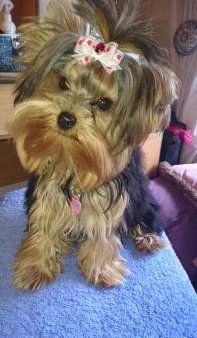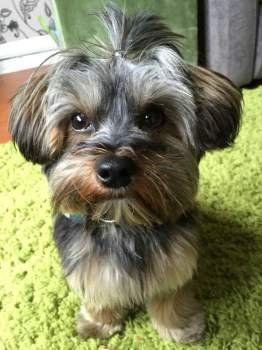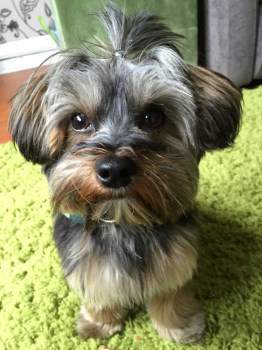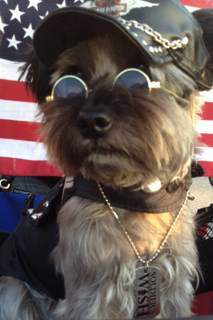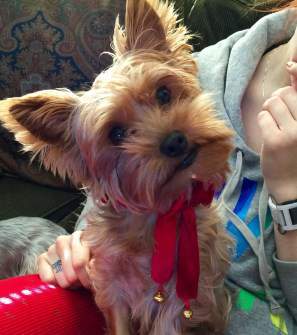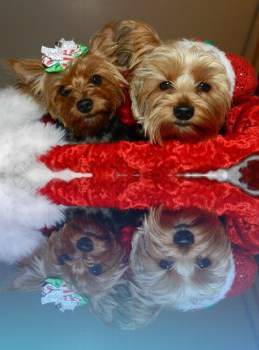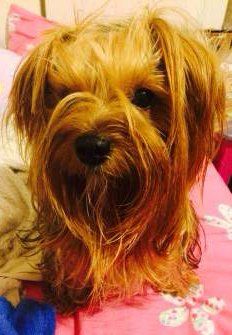Yorkshire Terrier Nose Issues
Overview
There are a number of issues that are related to a Yorkie's nose that you should be aware of. Issues can pop up quickly.
Though some concerns are more common depending on the time of year, each season brings about a new element that can affect the nose of a dog of any age. Whether your Yorkie is currently having a problem or you want to be prepared to react quickly if something develops, this page will be your guide for all nose related elements.
We will go over:
- What is ideal - Wet VS Dry, Warm VS Cold noses
- When a Yorkie's nose is overly dry
- Cracked noses, peeling
- Crusting and sores
- Runny noses
- Bleeding from the nose
- Color changes
- Proper protection of the nose
Please note:
YorkieInfoCenter is reader-supported, and some of the product suggestions on this page are affiliate links. As an Amazon Associate we earn from qualifying purchases. This is at no extra cost to you and helps us continue providing free, high-quality information.
And a consistently overly dry nose can lead to cracking and peeling. If your Yorkie's nose fluctuates from moderately moist to slightly dry, without any other issues, this would be considered normal.
Some elements that can cause temporary dryness or are a precursor to more severe drying issues include:
- Too much sun exposure (even if indoors and the dog is under a window, etc.)
- Chapping from winter weather or excessively licking the nose
- Being situated close to a heat source (heating vent, radiator, etc.) this is due to both the heat and the dry air.
- When just waking up -One of the leading causes of a nose feeling wet is that the puppy
or dog licks it throughout the day; since this doesn't happen when a Yorkie sleeps, it may be dry when he first wakes up.
If your Yorkie's nose is regularly dry without any other red flag issues (peeling, cracking), it's recommended to:
- Move the dog's resting area away from heat sources, if applicable
- Use a humidifier if the air in the house is very dry; this is most common in the wintertime
- Protect the nose with balm or butter (more ahead) to guard against outdoor elements; this is for both hot sunny days and cold winter days.
Ahead we will discuss chronic, severe dry nose problems with other signs such as peeling and/or cracking.
Cold or Warm -
With this element, there can also be a range of what is considered to be normal. If a Yorkie has a dry nose, it may automatically feel warmer to the touch than if it were moist. In general, it is common for a Yorkshire Terrier's nose to fluctuate between feeling cold and warm.
There are some things that can temporarily make a dog's nose quite warm:
- Sun exposure - The nose leather naturally does not have any protection from the sun and if a Yorkie is outside for 30 minutes or more on a hot, sunny day the leather can absorb the heat, making it feel warm.
- Slight dehydration - A loss of between 1 to 5% of body fluids constitutes slight dehydration and can cause the nose to feel warm and dry, along with possible trouble in focusing, irritability and/or headache (the dog may rub his forehead against surfaces)
If your Yorkie's nose is regularly warm without any other troubling signs (fever, lethargy, cracking, and/or feeling hot, etc.), it is a good idea to:
- Protect the nose from too much sun exposure (more ahead)
- Make sure that your Yorkshire Terrier is drinking enough water. Dogs that are not hydrating enough can often be encouraged to drink more when a canine water fountain is employed.
Dry, Cracked and/or Peeling Noses
- Dehydration - A Yorkshire Terrier may be slightly to moderately dehydrated without any other signs other than dryness; though issues such as irritation, decreased ability to focus and lethargy may not be immediately picked up by some owners. Yorkies should drink a minimum of 1 ounce of water for each pound of body weight; however this can double depending on the dog's activity level, health status and temperature that the dog is exposed to (both indoors and outdoors).
Using a canine water fountain can work well to encourage a Yorkie to drink more. Additionally, adding water-rich foods to his meals or offering them as snacks can count toward the dog's daily water intake… Watermelon, raspberries and/or blueberries are good choices as they are safe for canines to eat in moderation and high in water (92, 87 and 85% respectively).
- Chapping
- The skin on a Yorkie's nose can become chapped and this is very common in the winter when weather can be harsh, with cold air and whipping winds.
At Home Treatment of Cracking and Peeling - Treatment for chapping, peeling and minor crusting issues will involve using a quality healing nose balm or butter. This will soothe the sensitive skin and add a layer of relief to nourish, heal and moisturize.
Here are some tips:
- We recommend a product that does not contain chemicals and is organic, if possible, since a puppy or dog will tend to keep licking at the nose and some of the balm will be ingested.
- Look for one that is scent-free, as a scented product may cause a Yorkie to resist having it applied.
- Apply this liberally each evening right before your Yorkshire Terrier goes to sleep
for the night.
- Also apply this to the nose every 4 to 5 hours. Near meal times, apply this after the Yorkie eats.
- Once the nose has healed, dab a small amount on 2 to 3 times per day so that the nose is shielded from future damage.
With the right product, expect to see improvement within 5 to 7 days and complete healing within 2 to 3 weeks. Do be sure to also address any issues of water intake and dry air in the house.
A really good nose balm is Snout Soother by the Natural Dog Company . This is 100% organic, non-toxic, and is fantastic for both prevention and to heal issues including drying, peeling, and cracking.
. This is 100% organic, non-toxic, and is fantastic for both prevention and to heal issues including drying, peeling, and cracking.
Many cases of cracking and peeling can be treated at home; however you will want to check with the vet, especially if there is:
- Bleeding - If cracks are deep enough that they are bleeding this often means that the issue involves all 3 layers of skin. Infection can set in.
- A sign of infection - A severely cracked nose leaves the skin open and vulnerable to bacteria and infection.
If there is any puss oozing from the cracks, if the nose appears to have areas that are swollen, if your Yorkie is showing signs of pain, if there is a fever, etc. these are red flags that the vet should perform an examination as antibiotics and other prescribed medications may be needed.
- The nose is not healing - If there seems to be no improvement after 7 days with the home remedy.
Beau, Photo courtesy of Karla Stewart
Nose Crusting and Sores
Most common:
Small crusty flakes can be sign of healing; if there were small cracks or pieces of skin that flaked off, those areas can scab over. Crusty scabs on the nose are often red or brown and can simply be the body's method of protecting the sensitive skin from germs while the skin cells rejuvenate.
Do not pick off any scabs, as this will delay the healing process. If you are giving your Yorkie a bath, the warm water and shampoo may loosen flaking pieces of crust and this is fine, just do not purposefully remove any with your fingers or tweezers.
There are
some medical conditions which can cause rather severe sores that crust over on the nose. This includes:
Discoid Lupus Erythematosus
- This is a type of skin disease that also affects the lips, ears
and eye lids. In some cases, there will be open sores on the genitals. With this disease, there can be discoloration to the dog's nose as well.
Treatment involves both corticosteroids and immunosuppressive medications. Since sunlight exposure can worsen the condition, owners are often instructed to apply sunscreen to the dog's nose for any outdoor activities.
Pemphigus Foliaceous
- This is an autoimmune skin condition. Symptoms include crusty skin lesions along with boils that most often develop along the bridge of a dog's nose. These often grow into somewhat rather large pustules that easily rupture and then turn into dried crusty scabs. With some dogs, this can travel up to include the entire muzzle and even up to the ears. In rare cases, it will develop on the paw pads. Minor cases are treated with topical hydrocortisone. Moderate to severe cases are treated with Prednisone. It should be noted that as a dog is tapered from this, the disease may flare up again.
Distemper
- This is rare and is typically only seen in puppies that have not been vaccinated. In regard to skin, changes to the paws is a more common symptom; however with some pups there will be crusting and a hardening to the nose. Other signs include sneezing, coughing, discharge from the eyes & nose, fever, lethargy, vomiting and/or diarrhea.
At home treatment for crusty nose issues
If a Yorkie has a minor case of crusting that can be attributed to an earlier bout of dryness or slight cracking due to weather, a lack of humidity, chapping or slight dehydration, this can be often treated at home using a quality balm or butter as with dry, cracked noses.
If you do not see improvement within 7 days or if there are any other symptoms, including but not limited to change in appetite, fever, vomiting, diarrhea, weakness and lethargy, the puppy or dog should be examined by the veterinarian.
Runny Noses
Many dogs naturally have a small degree of a very thin, clear nasal discharge, however this is often not noticed due to the dog licking the nose before owners take notice.
If discharge is runny enough that fluid leaks out soon after wiping the nose with a dry cloth, if the discharge has any color to it (yellow, gray, green, brown, etc.) or if the discharge is thick, this points to a health issue
that will need veterinary treatment.
Possible reasons include:
Allergies
- This is by far the most common reason why a Yorkshire Terrier will have a runny nose. And this can take some owners by surprise since allergies can develop in a Yorkie of any age, at any time. This includes seasonal allergies (pollen, weeds, grasses), food allergies (the most common cause is not whole foods, but the chemical preservatives, coloring and flavoring that can be found in commercial brands) and contact allergies (carpeting, laundry detergent, material such as wool, etc.)
Of these three, seasonal allergies are the most likely culprit of a runny nose without any other signs such as itchy skin (though this can occur as well).
Treatment can range from OTC Benadryl for acute episodes to prescribed antihistamines for moderate to severe cases.
Joey, 3 years old
Photo courtesy of Carol Hunter
Keeping the house as free from allergens as possible is an important part of treatment. HEPA certified filters should be used in both AC's and in vacuum cleaners. Bedding and other washables should be washed and dried using hypoallergenic detergent. More frequent baths may be needed to wash pollen and other airborne particles off of the Yorkie's coat.
A blockage
- If you have a curious Yorkshire Terrier, you'll understand how common this is. A wide range of tiny items can be sucked up into the nose when the dog is sniffing around. This includes blades of grass, seeds… even such random things such as pencil erasers and a small artificial nail has been recovered from the nose of toy breeds that inadvertently snorted these objects.
In some cases, you may be able to spot the culprit and if it is visible, you may be able to remove it with a tweezers. If you are unsure, wait for the vet to do it. In some cases, it will be lodged further up the nasal canal, where it causes quite a bit of discomfort. Signs are odd breathing, snorting, pawing at the nose and/or slight bleeding, along with discharge that may be leaking out of just one nostril.
The veterinarian will be able to remove the obstruction; though this sometimes needs to be done with the dog under sedation.
Tooth infection
- The roots of the upper teeth are located very close to nasal passages and for this reason, a dental infection can cause a runny nose. Even if you routinely clean your Yorkie's teeth, offer healthy dental treats and have his teeth examined by the vet, infection can still occur. Many Yorkies will eat less, due to discomfort and/or may seem anxious or distressed (tooth pain can be quite severe). This is treated on a case by case basis, with possible extraction and with antibiotics to clear up the infection
.
Less common causes
- There are a wide range disease and conditions that can trigger a runny nose. Rare, yet possible include but are not limited to cryptococcosis (a fungal disease), nasal growth (polyps , tumors), distemper and pneumonia.
Melody, 3 years old
Photo courtesy of Steve & Robin Timm
Bloody Noses
Seeing your Yorkshire Terrier have a bloody nose (Epistaxis), is understandably worrisome.
Let's look at some possible causes:
Trauma
- Even if you did not see it occur, it only takes a split second for a dog to bonk his nose against something hard enough to cause an acute bloody nose.
Let's go over what to do if your Yorkie gets a nosebleed:
1)
Try to remain calm, since your dog will pick up cues from you (both your tone of voice and your actions), which can cause him/her to become stressed as well and this can increase the rate of blood loss.
2)
Gently apply a soft ice pack (wrapped in a washcloth) to the bridge of the nose, while you are seated and have your Yorkie cradled in your arms. Apply a light, steady pressure more so to the nostril that is bleeding.
3)
If the bleeding does not stop after 15 minutes, it will be time to take the dog to the vet.
Remember that if you do not know what caused the trauma to the nose, it may also involve other parts of the body… for example, if a Yorkie fell from the sofa and landed wrong, there may be injury to the hips, back, neck, etc.
Always look for any signs of distress (limping, whining, resting in an odd position, etc.) and bring your dog to the vet clinic if you suspect that there are any injuries.
Other less common reasons
- This list of what can cause an acute bloody nose or a chronic nose bleeding issue are very wide ranging. This includes seemingly random events such as a snake bite (we do know of one toy dog that was sitting by a river with her owner, was bitten by a snake and sadly passed away from the toxin)… to cancer, nasal polyps, or even Rocky Mountain spotted fever.
It is never normal for a dog to have nosebleeds and unless it was caused by a minor trauma that quickly responded to at-home treatment, always bring your Yorkshire Terrier to the vet to have this symptom diagnosed.
The Color of a Yorkshire Terrier's Nose
Per the AKC, FCI, KC, CKC and other major kennel clubs, the Yorkshire Terrier breed 'should' have a black nose.
This is the breed standard. However, there are some Yorkies that have brown noses or black noses with one or more medium to dark brown spots.
While considered a fault in the show ring, these natural variations in skin pigmentation will not be related to any sort of health issue. It should be noted, however, that this is a genetic trait and dogs that have
color faults should not be bred, since the goal of ethical breeding is 'betterment of the breed' which includes striving to meet the strict breed standard guidelines.
This said, brown nosed Yorkies are exceedingly adorable and often have a unique, special look that owners appreciate.
And these two elements are what can cause the nose to become discolored.
Another issue sometimes seen with plastic bowls is a reaction to a chemical known as p-benzylhydroquinone. This chemical leaks out into food and water and is absorbed into the skin, leading to changes in skin pigmentation and swelling, most notably on the nose and lips.
Stainless steel bowls are recommended; these stay in place better, are easier to clean, there is less chance of bacterial growth and of course, they do not have dyes.
Seasonal Fading
- There are some breeds that are very sensitive to sun exposure (like the Maltese) and while the Yorkshire Terrier is not traditionally one of them, some are more light sensitive than others. This is sometimes referred to as 'snow nose' or 'winter nose'.
This change has to do with vitamin D and how skin pigmentation is triggered by sunlight.
For those Yorkies that do have this sensitivity, the nose will lighten during the winter
and become darker during the summer. In extreme cases, the nose may develop a pink spot (often right in the center).
Pink spots
- The most typical reason for a pink spot to appear on a Yorkshire Terrier's nose is a peeling of the top layer (or two) of skin, that then exposes the inner layer. In these cases, it will be important to protect this delicate area with a quality nose butter or balm to allow it to heal. For some dogs that have this sort of deep peeling, there may permanently be a lighter color where the damage occurred.
Nasal depigmentation
(Dudley nose/ vitiligo)
- While uncommon with this breed, this is a condition in which the nose fades, sometimes quite dramatically. It can go from black to brown to pink and even white. No treatment is given, as this is seen as a cosmetic issue only.
Dogs can become distracted and/or may not drink stale water. Wash the bowl each day, offer water that has been filtered and bring along some H20 when you take your Yorkie outside for walks and exercise.
4) Supervise outdoor sniffing.
Oh, the trouble our dogs can get into when they are allowed to use their nose to explore when outside… From red ant bites, to bee stings to snorting up a pebble… a wide range of problems can occur if a dog sticks his nose under bushes, in tall grasses or other areas. While dogs do need to sniff around (after all, it satisfies a natural canine instinct), do be careful about where your Yorkie does this.
Things to Do Now:
Become a Member - Joining the YorkieInfoCenter family is free & easy! Receive reminders when we add new pages to this site and suggest a topic for us to write about. You will also receive a free & helpful Welcome eBooklet.
Browse Yorkshire Terrier Supplies, for all of our top recommended items to ensure optimal care.

